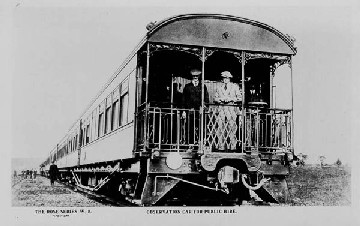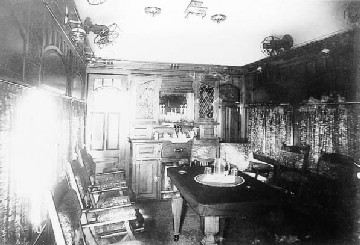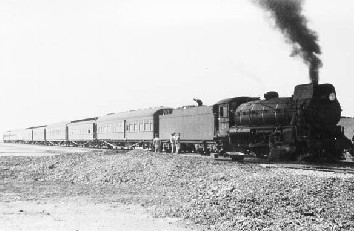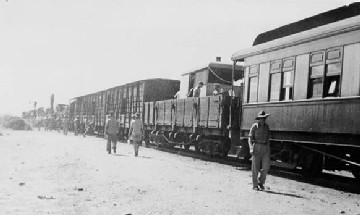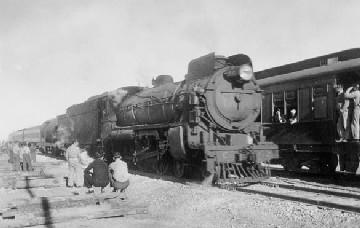
On 7th October 1941, John Curtin was sworn in as Prime Minister of Australia - a nation at war. His first Cabinet meeting was held, not in Canberra, but in Melbourne as it was the headquarters for the army and navy. Two months later the war situation was to take a dramatic turn with the Japanese bombing of Pearl Harbour. There were frequent war cabinet meetings, usually held in Melbourne, with Curtin using the train, or being driven by car, to commute between Canberra and Melbourne. That Christmas was the first that John Curtin and his wife were unable to spend together.
In late January 1942 Curtin made his first trip to Perth as prime minister. How different this travel was from his early days of sleeping on hard seats! Now as prime minister he had Ministerial and State carriages for his use. On the long journey across the Nullarbor the Commonwealth Railways provided the 'Prince of Wales' carriage for his use from Port Pirie to Kalgoorlie.
View a film clip of passenger and freight trains crossing the Nullarbor, including a glimpse of the observation platform of the 'Prince of Wales' carriage.
This luxurious carriage, with its observation end platform, had been completed in 1920 ready for the visit to Australia of HRH the Prince of Wales. Here the Prince is seen as his train crosses the Nullarbor.
Photograph: Australian Railway Historical Society Archives
Since 1920 the 'Prince of Wales' carriage had been used by royalty and all prime ministers. When a derailment occurred during the Prince's journey in July 1920, Curtin commented on the incident and his views on royalty in his Westralian Worker editorial(9.7.20).
It is ironic that Curtin, who questioned the role of royalty in his editorials during this 1920 visit, should spend six return trips across the Nullarbor from 1942 to 1944 in the very carriage completed for the use of royalty.
For Curtin, the carriage became not only a means of travel, but a mobile office and a refuge for him. On that first trip home as prime minister, the press release from his office noted:[7]
'There
will be no formal reception on arrival on Saturday morning. He will spend
the weekend with his family. He has not seen his son (who is in the RAAF)
and his daughter since last August. Mr Curtin, who will leave Perth for
Canberra the following day (Thursday), will be in constant touch by teleprinter
with cabled advices from overseas and by telephone with Ministers.'
The interior of the dining saloon in the 'Prince of Wales' carriage
Photograph: National Archives of Australia, Adelaide B3104 Volume 4 Box 4, 956
But the trip was
not uneventful. Mr Sydney Gray, on leave from 2/1st AIF, was one of the
troops travelling on the same train. Flood waters covered the tracks east
of Kalgoorlie and the young soldier's wedding was scheduled for that Saturday
in Perth. He later recounted the story of his
chance meeting on the Trans Australian Line
with the prime minister that day.
The 'Prince of Wales' carriage, easily identifiable by its centre doorway, is attached to a troop train crossing the Nullarbor during the war years.
Photograph: P Rogers Collection. Courtesy late L Smith
During those busy final years of the war general train movements across the Nullarbor were restricted with civilian travel only possible in an emergency. Even the travel of the Western Australian Premier to attend War Cabinet meetings in Melbourne was difficult to arrange and on three occasions he travelled one way with Curtin in the special carriage.
This did not mean
that travel was easy for the troops. As the Commonwealth Railways were
short of passenger carriages, they converted (with a minimum of change)
cattle wagons to each carry sixteen men across the Nullarbor.
This meal stop for troops on the Nullarbor shows both cattle wagons converted for troop carrying and a Wiles cooker in an open wagon.
Photograph: P Rogers Collection. Courtesy R Vippond
Curtin travelled by train to attend his daughter's wedding
in Perth and when returning once again endeared himself to the troops
along the way. John Burley
was a Sergeant heading to WA when he saw Curtin and recalled: [8]
At one of these stops (Cook or nearby), the word spread that the 'Trans' was coming from the west, the PM John Curtin was aboard and that he would address us from the observation platform at the rear of the train. John Curtin was standing on the observation platform as the train drew to a halt. We gathered around. He spoke for 5 to 10 minutes. His voice was loud and clear and his message simple and clearly directed to his audience of young and apprehensive servicemen. He spoke of the latest war news (which was grim) and the determination of the Government and the country to achieve victory, even though there was, perhaps worse news to come and that it would be a long and hard struggle ...
It raised the morale of us all and gave us determination to face whoever lay ahead with the confidence that we had the support of the Prime Minister. We gave him three cheers, the Trans went on its way and he remained on the observation platform to wave goodbye.'
Troop trains crossed each day on the Nullarbor, sometimes bringing the opportunity for the troops to mix - even playing a game of cricket on some occasions.
Photograph: P Rogers Collection. Courtesy L J Purcell
For Mrs Curtin the Nullarbor train trip allowed some relaxation. On one trip she knitted a pair of Russian bed socks as a seventy-seventh birthday present for poet Dame Mary Gilmore.[9]
Continue the story
of the Prime Minister

